
35-Minute Full-Body Strength, Power and Abs Workout
This dumbbell-only workout hits every major muscle group — upper body, lower body, and core — while boosting both cardiovascular endurance and functional strength. No expensive gym memberships or specialized equipment needed, just grab a set of dumbbells and you’re ready to go.
Although I love “strict” strength training, as a fitness trainer, I’ve discovered how important it is to add explosive movements and stabilization exercises to your routine.
Resistance training is about more than just lifting weights. The 3 main factors of resistance training are strength, power and stabilization.
That means the best home workout would include movements that help us develop the ability to:
- Generate force (strength training)
- Produce explosive power (plyometrics)
- Maintain stability (core strength)
That’s why the most effective home workouts blend traditional strength exercises, plyometric moves for explosive power, and core-focused exercises for stability. This approach inspired our fan-favorite “SPA” (Strength, Power, Abs) workouts. Dumbbells are ideal for this style because they build lean muscle, engage stabilizing muscles and allow a full range of motion.
I like this style of dumbbell-only training because of its functional fitness benefits. Functional fitness is all about training your body for real-life movements, like bending, lifting, twisting and jumping – things we do every day as parents, professionals or just human beings. By combining multiple muscle groups, full-body circuits improve coordination, balance and overall strength, making daily tasks feel easier.
Circuit-style dumbbell workouts that include goblet squats, chest presses, bent-over rows, glute bridges, lateral raises and Romanian deadlift push every muscle in the body to fatigue, without the need for specialized gym equipment or machines.
Dumbbell workouts are generally safe for most people, but those with certain injuries, joint issues or conditions that limit mobility should approach them cautiously. If you’re recovering from surgery or dealing with chronic pain, check with a healthcare professional before starting a dumbbell routine.
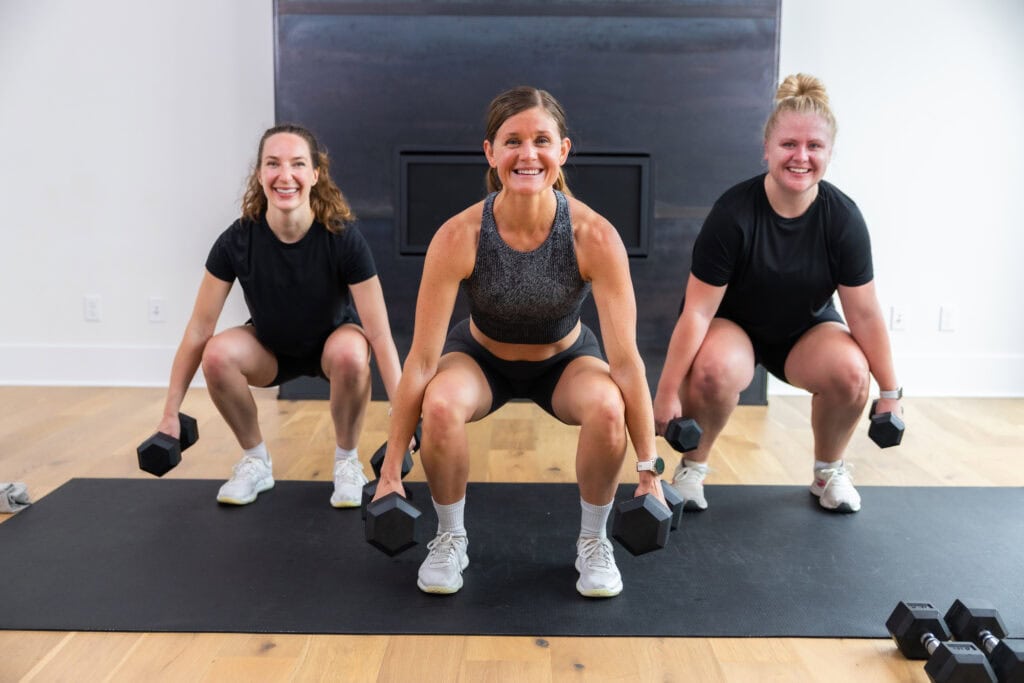
Workout Details
This full-body dumbbell workout combines 12 of the best exercises to build strength and lean muscle at home. Modifications are provided for both beginners and advanced athletes to scale the workout to meet your needs.
This workout also includes a dynamic warm-up and a comprehensive cool-down. Add full body workouts like this one to your home dumbbell workout plan 1-2 times a week to increase muscle building and definition.
If you’re looking for extra core engagement, check out my 30-Day Ab Challenge.
Workout Equipment:
Medium Pair of Dumbbells. I recommend between 5-25 lbs depending on your fitness level. We used 15 and 20 lb dumbbells in today’s workout.
Workout Instructions:
Follow along with the guided Full-Body Dumbbell Workout at home, led by me — your certified personal trainer, Lindsey Bomgren.
Your Workout Looks Like This:
- 4 Full Body Circuits (3 exercises per circuit)
- Timed Intervals (30 seconds of work, 15 seconds rest; complete as many repetitions as you can in the timed interval)
- Repeat Each Circuit x2 Sets
Workout Outline
CIRCUIT ONE
- Strength: Eccentric Squat
- Power: Side-to-Side Squat Hop
- Abs: Standing Windmill
CIRCUIT TWO
- Strength: (3) Back Rows, (2) Bicep Curls and (1) Shoulder Press
- Power: Burpee and Alternating Shoulder Press
- Abs: Push Up and Cross Body Knee Drive
CIRCUIT THREE
- Strength: (3) Split Lunges, (2) Staggered Deadlifts and (1) Dumbbell Clean Squat
- Power: Dumbbell Lunge Drops
- Abs: Half-Kneeling Hinge Swing, Stand and Knee Drive
CIRCUIT FOUR
1. Eccentric Squat
Targets: Legs, glutes, quads, hamstrings, hip flexors and core.
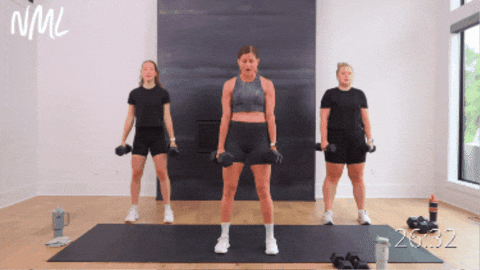
How To Do Eccentric Squats
- Stand with feet hip-width apart, knees slightly bent. Hold dumbbells in both hands at your sides, palms facing in.
- On a 3-count, slowly lower your hips until your knees are bent at 90 degrees and your thighs are parallel to the floor.
- Then, hold for a 2-count at the bottom of your squat.
- Finally, press evenly through your heels to drive up on a 1-count, returning to the starting position.
2. Side-to-Side Squat Hop
Targets: Gluteus medius (outer glute that controls hip movement and side-to-side movements), hamstrings, hips, quadriceps, calves and core.

How to Do a Side-to-Side Squat Hop
- Start with your feet wider than shoulder-width, toes slightly turned out, holding a dumbbell in your right hand.
- Lower into a squat by pushing your hips back and bending your knees, keeping your chest tall and weight in your heels.
- From the squat, explosively jump sideways, switching the dumbbell to your left hand as your feet come together.
- Land softly with knees slightly bent to absorb impact.
- Drop back into a squat and hop to the opposite side, repeating in a continuous side-to-side motion.
Modification: Omit the hop, performing just side-to-side squats.
3. Standing Windmill
Targets: Obliques, abs, upper back, outer glutes, inner thighs, hamstrings, upper body and shoulders.

How to Do a Standing Windmill
- Start in a wide stance, holding a dumbbell in your left hand, directly above your shoulder.
- Rotate your right foot out 90 degrees so your right toes are pointing towards the top of your mat, then pivot your left foot slightly inwards (about a 45-degree angle). Think right heel aligns with left arch.
- Focus on creating and maintaining length through your waist as you hinge at the hips, sliding your right arm down your right leg. Keep your left hand directly above your left shoulder, maintaining a straight line with the dumbbell. Range of motion will look different for everyone.
- Then, squeeze through your obliques to pull your torso back upright, returning to starting position.
Modification: Omit the dumbbell and perform bodyweight windmills.
4. Back Row, Bicep Curl and Shoulder Press
Targets: Upper arm, shoulders and upper back; specifically the biceps, front and middle heads of the deltoids (shoulders), trapezius and rhomboids (back).
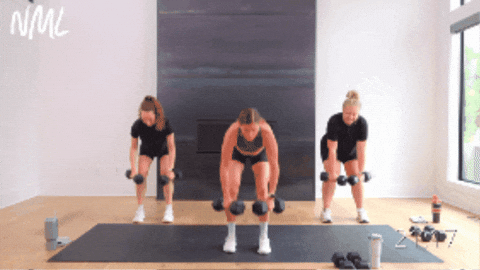
How to Do a Back Row, Bicep Curl and Shoulder Press
- Start standing with feet hip-width apart, knees slightly bent. Hold 1 dumbbell in each hand, palms facing in towards your body.
- Hinge forward at the hips until your body is in a straight line, neck in line with your spine, flat back, and belly button pulled back towards your spine to maintain proper form.
- Pull your elbows towards your rib cage, squeezing shoulder blades together to perform a bent-over back row. Lower the dumbbells with control.
- Then, stand tall, and rotate your palms to face in towards each other, finding a hammer curl grip. Bend your elbows, curling the dumbbells up towards your shoulders before lowering with control.
- On the second curl, keep the dumbbells at your shoulders, then press the weights straight overhead, elbows near your ears. Lower the dumbbells with control.
5. Burpee and Alternating Shoulder Press
Targets: Glutes, hamstrings, hips, calves, low back, shoulders, abs and core.
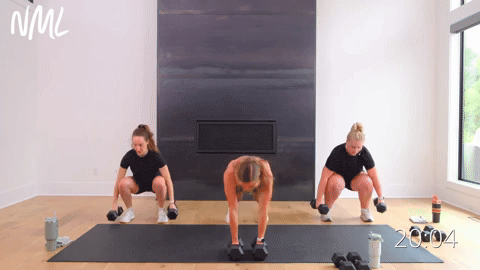
How to Do a Burpee and Alternating Shoulder Press
- Stand with feet shoulder-width apart, holding a set of dumbbells in your hands, palms facing in towards each other.
- With a soft bend in the knees, hinge at your hips to lower your torso as you slide the dumbbells down in front of your legs. Think about pushing your hips back behind you. Hinge until you feel a stretch in the back of your legs.
- Set the dumbbells on the ground between your feet and perform a burpee by jumping your feet back to high plank position. Hands remain on the dumbbells.
- Lower your chest all the way to the floor, then push yourself back up into a high plank.
- Jump your feet back in and immediately stand tall, driving through the heels as you pull the weights up towards your hips. Rather than stopping at your hips, clean the dumbbells up to shoulder height.
- Perform a shoulder press on the right by pushing the right dumbbell overhead until your arms are fully extended. Then perform a shoulder press on the left by pushing the left dumbbell overhead until your arms are fully extended.
- Lower the dumbbells down to shoulder height, returning to the starting position.
Modification: Option to perform dumbbell squat clean into an alternating shoulder press.
6. Push-Up and Cross Body Knee Drive
Targets: Chest, shoulders, triceps, back, upper arms, glutes, quads, abs, obliques and core.
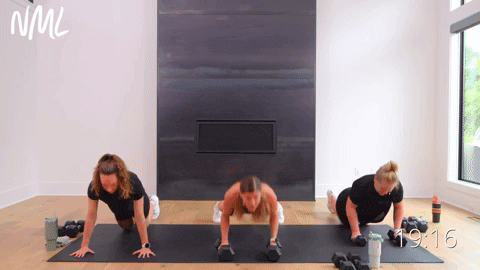
How to Do a Push-Up and Cross-Body Knee Drive
- Start in a high plank position with your shoulders stacked over your wrists. Your weight is evenly distributed among all 10 fingers.
- Hold this high plank position, maintaining a straight line with your body, and gaze slightly in front of you.
- Slowly lower your chest down toward the ground. Your elbows should fall back towards your hips (not out to the sides).
- At the bottom of your push-up, exhale as you push back up into a high plank position.
- Hold your high plank position as you perform 2 cross-body knee drives to pull your right knee towards your left elbow, then immediately reverse the movement. Send the right foot back to the high plank before pulling the left knee towards the right elbow.
Modification: Option to perform push-ups from a kneeling position or try push-up progress alternatives if you are working towards push-ups from your toes.
7. Split Lunge, Staggered Deadlift and Dumbbell Clean Squat
Targets: Lower body (glutes, hamstrings, hips, quads, calves), upper body (trapezius, deltoids, lower back), abs and core.

How to Do a Split Lunge, Staggered Deadlift and Dumbbell Clean Squat
- Start standing, feet hip-distance apart and knees slightly bent. Hold a dumbbell in each hand in front of your thighs.
- Step your right foot back into a reverse lunge, dropping your back knee down towards the ground as you lower your hips. Aim to get your front thigh parallel to the floor.
- Press through your front left heel as you straighten both knees, standing tall.
- Then, step your right foot forward, planting it on the ground slightly behind your left foot (finding a staggered stance). Feet are hip-distance apart.
- Hinge forward at the hips to perform a deadlift, pushing your hips back as you lower the dumbbells down along the front of your body. Focus on keeping your back in neutral alignment with your neck and shoulders. Keep a slight bend in your knees.
- Then, drive through your heels to push your hips forward, squeezing your glutes as you return to a standing position.
- After the deadlift, step your right foot up to meet your left. As you press your hips forward, “clean” the dumbbells up, catching the dumbbells at your chest in a front rack position.
- Then, lower your hips, bending your knees to 90-degree angles as you perform a front squat.
8. Dumbbell Lunge Drops
Targets: Legs, glutes, quads, hips, hamstrings, calves and core.

How to Do a Dumbbell Lunge Drop
- Start standing with feet hip-width apart, knees slightly bent, and core engaged. Hold a dumbbell in your right hand at your side.
- Step your right foot back into a reverse lunge, lowering until both knees form 90-degree angles.
- From the lunge, explode upward into a jump. As you bring your feet back together at the top, switch the dumbbell into your left hand.
- That’s 1 rep. Repeat, alternating which foot “drops” back into the reverse lunge each time.
Modification: Option to perform step back reverse lunge (omitting the jump) with a dumbbell swing. If you’re experiencing knee pain, modify with lunge exercise alternatives.
9. Half-Kneeling Hinge Swing, Stand and Knee Drive
Targets: Lower body (hips, glutes, quads), core, abs and shoulders.
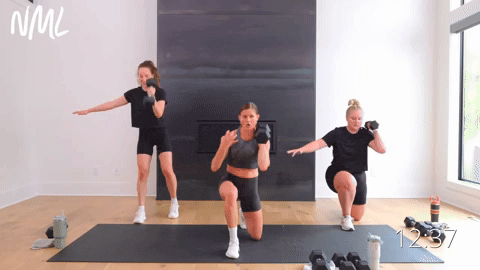
How to Do a Half-Kneeling Hinge Swing, Stand and Knee Drive
- Start in a half-kneeling position — left knee bent at a 90-degree angle, foot on the mat in front of you and right knee bent at 90 degrees, on the ground underneath your hips.
- Hold 1 dumbbell in the right hand with a neutral grip (palm facing your left thigh).
- Perform a half-kneeling hinge swing by hinging at the hips with the dumbbell between your legs. Then drive your hips forward, powering the dumbbell up to your right shoulder; right elbow in line with your shoulder (maintaining a neutral grip).
- Then drive through your left glute to stand up, bringing feet hip-width apart and parallel as you push the dumbbell overhead with your right hand. Press the dumbbell straight overhead, locking out the elbow, right bicep should be near right ear.
- Slowly lower the dumbbell back down towards the right shoulder as you step the right leg back to a lunge, lowering the right knee back to the ground with control. Simultaneously, lower the dumbbell in your right hand back between the legs. That’s 1 rep.
Modification: Stay standing throughout the entire movement. Perform a staggered stance dumbbell swing instead of a kneeling swing.
10. Glute Bridge, Skull Crusher and Narrow Press
Targets: Glutes, hamstrings, triceps, shoulders, chest and core muscles.
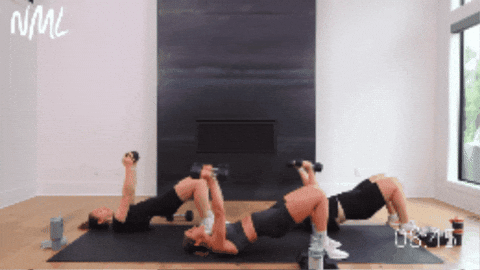
How to Do a Glute Bridge, Skull Crusher and Narrow Press
- Lie on the ground, knees bent at 90 degrees and feet flat on the floor. Hold 1 dumbbell in each hand, weights resting on your hips.
- Then, press through your heels to lift your glutes off the mat, squeezing your glutes as you lift. Think about keeping your core engaged and knees in line with your hips.
- With control, lower your hips until they are hovering an inch off the mat.
- Then, hold a glute bridge as you lift the dumbbells up, elbows extended, dumbbells stacked directly over your shoulders, palms facing in towards one another.
- Bending at the elbows, slowly lower the dumbbells towards your head. Then, squeeze through the back of your arms to straighten your elbows, returning the dumbbells overhead.
- Then, lower your elbows towards your ribcage before pressing both dumbbells up in a straight line, completing a narrow chest press.
11. Single-Arm Chest Press and Straight Leg Lift
Targets: Deep core muscles (transverse abdominis), lower abs, hips, chest, shoulders and triceps.

How to Do a Single-Arm Chest Press and Straight Leg Lift
- Lie flat on your back with a slight pelvic tilt, pressing your lower back into the mat. Bend your right knee, planting your foot on the floor, and extend your left leg straight above your hip.
- Hold a dumbbell in your right hand, arm extended straight toward the ceiling.
- Inhale as you bend your right elbow to lower the dumbbell toward your pecs. At the same time, lower your left leg toward the floor, hovering your heel just above the mat.
- Exhale as you press the dumbbell back overhead, guiding it toward your extended left ankle.
Modification: Reduce range of motion of your legs, performing bent leg lowers rather than extending the legs fully.
12. Dumbbell Overhead Pull and Crunch
Targets: The lower abs and obliques. Also improves stability throughout the lower back, hips and spine.
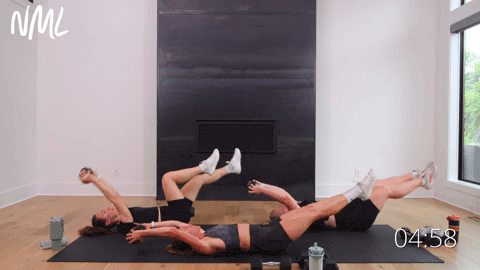
How to Do a Dumbbell Overhead Pull and Crunch
- Start lying on your back, core engaged, holding a single dumbbell horizontally between both hands. Extend your legs and arms away from each other, floating them off the mat.
- Squeeze through your upper abs to lift your torso off the mat, crunching the dumbbell from overhead to your chest as you perform a sit-up.
- Slowly and with control, roll back to the mat and extend your arms and legs away from each other, returning to starting position.
Modification: Option to perform a weighted dead bug.
FAQs
The best dumbbell workout routines include a combination of arm workouts, leg workouts, full body workouts, core workouts and mobility workouts. Beginner workout routines may focus on three days of training a week, while more advanced split training workout plans tend to be structured in 5-day workout splits, or training 5 days per week.
Yes, you can absolutely build muscle mass with a dumbbell full-body workout plan. Compared to many weightlifting gym machines, dumbbell exercises often allow for a greater range of motion and typically engage more of the smaller, stabilizing muscles in the lower body, upper body and core. They also allow you to strength train in multiple planes of motion, mimicking real-life movement patterns. Ultimately, you need to implement progressive overload in order to build muscle and see results (using heavy weights).
I’ve been in the fitness space for over 10 years and have built out my own home gym. If you’re looking to invest in dumbbells, a barbell set, or start building your own setup, I highly recommend Torque Fitness Gear (you can use code NML5 for a discount).
You can build muscle using exclusively home dumbbell workouts. Compared to using gym machines (such as a leg press machine or lat pull-down machine), dumbbells engage more of the smaller, stabilizing muscles in the lower body, upper body and core. They also allow you to strength train in multiple planes of motion, mimicking real-life movement patterns.
More Total-Body Workouts
Full Body WorkoutsPin This At-Home Dumbbell Workout (Strength, Power and Abs)
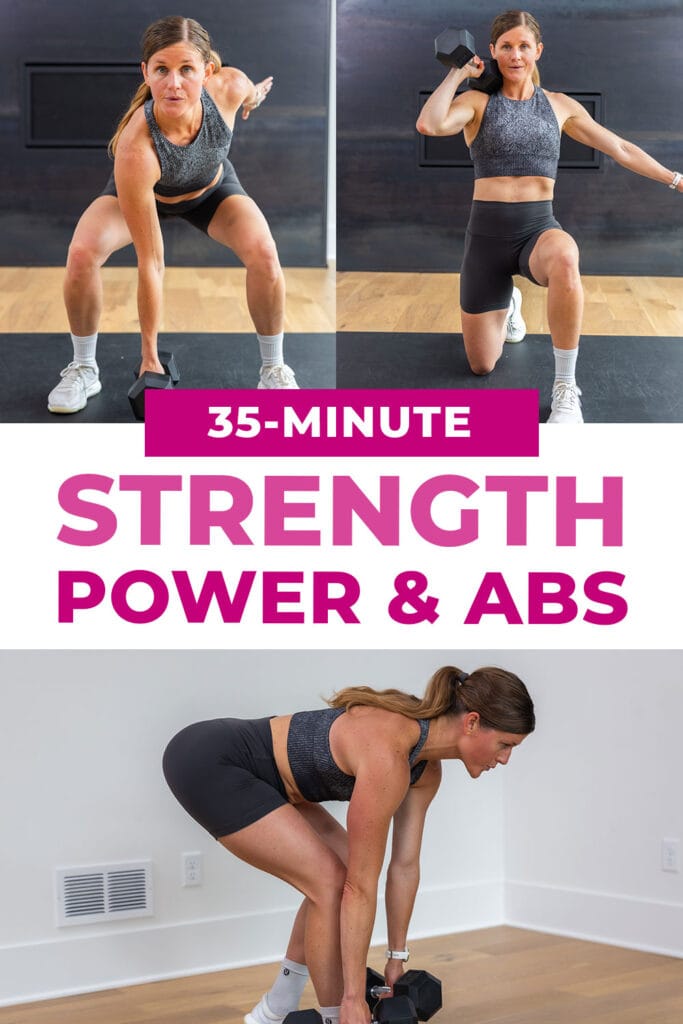
This post includes affiliate links. I do earn a commission for products purchased using these links (at no additional cost to you). Thank you for supporting Nourish Move Love, making the content you see on this blog possible.











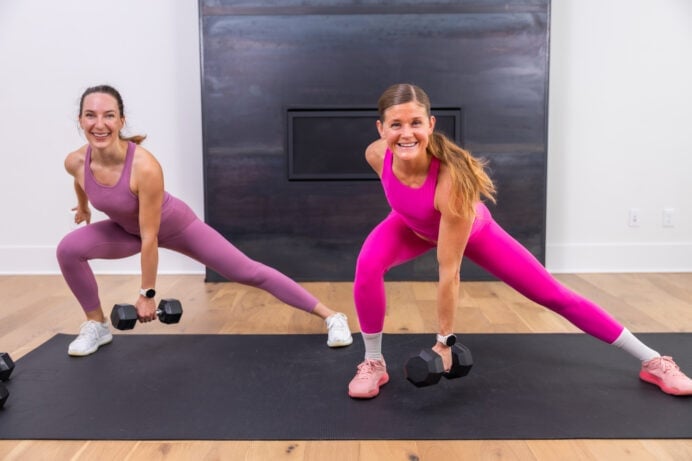

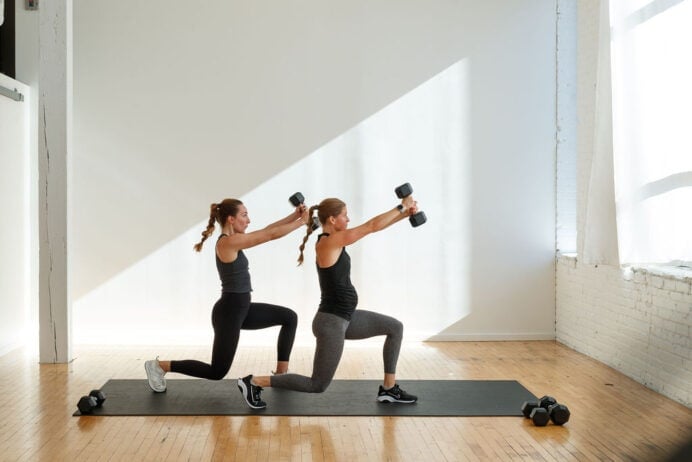

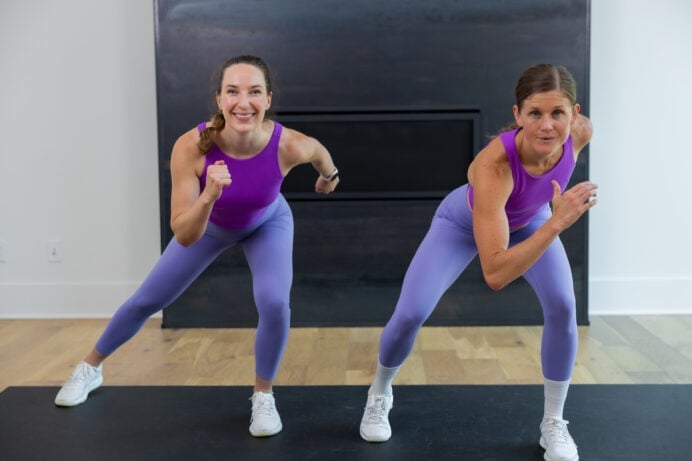
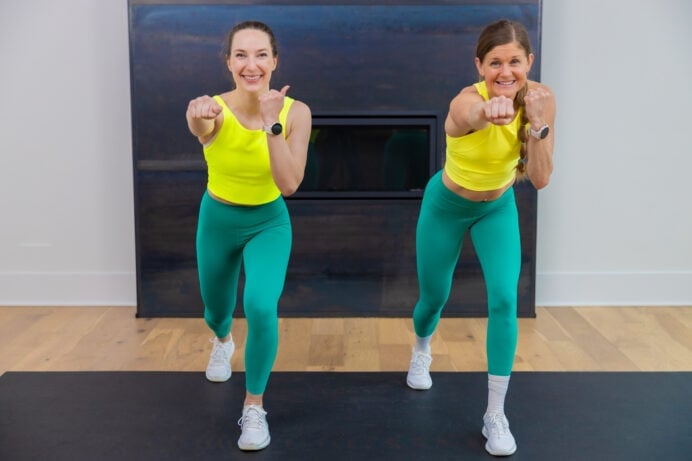

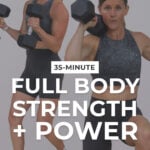
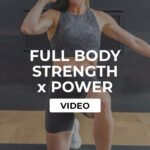
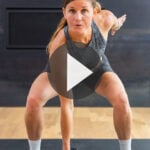
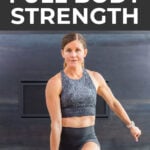

Can I get the name of the spice used on Rachel’s favorite Pork Recipe? The one she said was sold at the MN State Fair! Thanks 🙂
Hi Nikki! Yes – Rachel loves the Martin County Magic pork seasoning from Martin County Pork! The seasoning is available in some local grocery stores and on the Martin County Pork website!